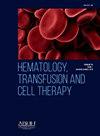CASE REPORT OF METASTATIC MELANOMA LESION AFFECTING AN EXTENSIVE AREA OF THE LEFT LOWER LIMB ON 18F-PSMA PET/CT AND 18F-FDG PET/CT IMAGES – INTENDING TO COMPARE THE DISTRIBUTION OF BOTH RADIOTRACERS IN THIS CANCER
IF 1.8
Q3 HEMATOLOGY
引用次数: 0
Abstract
Introduction/Justification
Positron emission tomography (PET/CT) using 18F-FDG has been widely used for staging and monitoring melanoma patients. Recent studies highlight the potential of 18F-PSMA PET/CT as an additional diagnostic modality, given the expression of prostate-specific membrane antigen (PSMA) in melanoma cells. Recent evidence indicates that anti-PSMA antibodies react with malignant melanoma neo vasculature, coupled with incidental findings reporting PSMA avidity in melanoma, the potential role of 18F-PSMA PET/CT as a novel diagnostic imaging technique in non-prostatic cancers looks promising.
Report
We describe below a case that illustrates the potential of 18F-PSMA PET/CT in evaluate melanoma lesions: 72-year-old female patient, Caucasian, single, with medical history of chronic obstructive pulmonary disease, diabetes mellitus, hypertension, smoking for 10 years (50 pack-years), and a cerebral aneurysm clipping in 2013 (which resulting in inability to walk). In 2022, she developed a sudden and progressive lesion on her left hallux, which spread to left lower limb over six months. She underwent two biopsies, confirming the diagnosis of melanoma. In 2024, the subject presented on physical examination a lesion affecting all the posterior portion of the lower limb, associated to an ulcerated vegetative lesion of approximately 10 cm on the medial portion of the left hallux. The immunohistochemistry findings described an invasive and ulcerated melanoma (Breslow 5 mm). On 16-October-2024 she underwent a 18F-FDG PET/CT founding an extensive densification of the subcutaneous tissue throughout the entire left lower limb, associated with multiple nodules, measuring up to 6.8 × 3.2 cm (SUVmax = 36.9). Furthermore, it was found left inguinal and femoral lymphadenopathy, and multiple pulmonary and hepatic nodules (SUVmax = 30.3). On the following day (17-October-2024), it was performed a 18F-PSMA PET/CT which found uptake of the radiotracer on the primary lesion in the left lower limb (SUBmax = 22.7), in the regional lymph nodes (inguinal and femoral) and pulmonary nodules (SUVmax = 32.1). Comparatively, the 18F-PSMA radiotracer showed smoothly less intense uptake in the left lower limb lesion and pulmonary nodules compared to 18F-FDG. On the other hand, hepatic nodules did not present 18F-PSMA uptake, while 18F-FDG uptake was moderately intense (SUVmax = 9.7). Due to the patient's multiple comorbidities, advanced age, poor general condition (Karnofsky Performance Status of 40%), and high surgical risk, invasive treatment was contraindicated. Palliative care was chosen instead.
Conclusion
Therefore, apart from the use of 18F-PSMA PET/CT in staging of prostate cancer patients, this method shows a great potential in the evaluating of metastatic melanoma, with a capacity of uptake in lesions comparable to 18F-FDG PET/CT (as demonstrated in this case), needing further and longer studies to confirm these advantages.
18f-psma pet / ct和18f-fdg pet / ct图像上转移性黑色素瘤病变影响左下肢广泛区域的病例报告-旨在比较两种放射性示踪剂在该癌症中的分布
介绍/理由使用18F-FDG的正电子发射断层扫描(PET/CT)已广泛用于黑色素瘤患者的分期和监测。最近的研究强调了18F-PSMA PET/CT作为一种额外的诊断方式的潜力,考虑到前列腺特异性膜抗原(PSMA)在黑色素瘤细胞中的表达。最近的证据表明,抗PSMA抗体与恶性黑色素瘤的新血管发生反应,加上在黑色素瘤中偶然发现PSMA, 18F-PSMA PET/CT作为一种新的非前列腺癌诊断成像技术的潜在作用看起来很有希望。下面我们描述一个病例,说明18F-PSMA PET/CT在评估黑色素瘤病变中的潜力:72岁女性患者,高加索人,单身,慢性阻塞性肺病病史,糖尿病,高血压,吸烟10年(50包年),2013年脑动脉瘤切断术(导致无法行走)。2022年,她的左拇突然出现了进行性病变,并在六个多月的时间里扩散到左下肢。她接受了两次活组织检查,确诊为黑色素瘤。2024年,受试者在体检中发现一病变,影响下肢后部的所有部分,并伴有左拇趾内侧约10厘米的溃疡性植物病变。免疫组化结果描述了侵袭性溃疡性黑色素瘤(Breslow 5 mm)。2024年10月16日,患者接受了18F-FDG PET/CT检查,发现整个左下肢皮下组织广泛致密化,伴多发结节,尺寸达6.8 × 3.2 cm (SUVmax = 36.9)。左侧腹股沟及股淋巴结病变,多发肺、肝结节(SUVmax = 30.3)。次日(2024年10月17日),行18F-PSMA PET/CT检查,发现左下肢原发病灶(SUBmax = 22.7)、区域淋巴结(腹股沟和股淋巴结)和肺结节(SUVmax = 32.1)有放射性示踪剂摄取。相比之下,18F-PSMA示踪剂显示,与18F-FDG相比,左下肢病变和肺结节的摄取程度较低。另一方面,肝结节不存在18F-PSMA摄取,而18F-FDG摄取中等强度(SUVmax = 9.7)。由于患者合并症多,年龄大,全身状况差(Karnofsky Performance Status为40%),手术风险高,禁忌行有创治疗。于是选择了姑息治疗。因此,除了将18F-PSMA PET/CT用于前列腺癌患者的分期外,该方法在评估转移性黑色素瘤方面也显示出巨大的潜力,其在病灶中的吸收能力可与18F-FDG PET/CT相媲美(如本例所示),这些优势还需要进一步和更长的研究来证实。
本文章由计算机程序翻译,如有差异,请以英文原文为准。
求助全文
约1分钟内获得全文
求助全文
来源期刊

Hematology, Transfusion and Cell Therapy
Multiple-
CiteScore
2.40
自引率
4.80%
发文量
1419
审稿时长
30 weeks
 求助内容:
求助内容: 应助结果提醒方式:
应助结果提醒方式:


